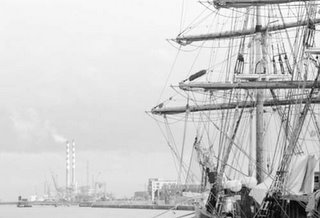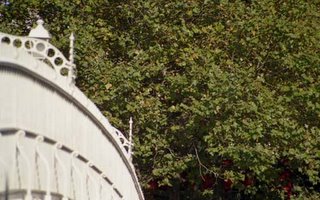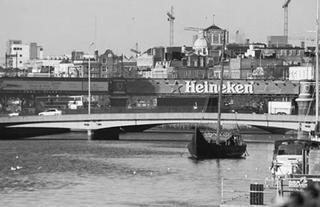 View more PhotosReplica emigrant famine ship
View more PhotosReplica emigrant famine shipThe story of the Jeanie Johnston is the story of one of the most momentious periods of Irish History - the era of the Great Famine that swept Ireland in the middle of the 19th century.
Emigration has been a feature of Irish life for centuries but the mass exodus which accompanied the Great Famine (1845-50) is unparalleled in Europe in a time of peace. At the time the potato was the staple diet of the Irish people and when it failed in consecutive seasons from 1845 to 1848 disaster struck.
Between 1840 and 1860 the population of Ireland was halved from 8 to 4 millions through famine and emigration. Two million people boarded the emigrant ships for North America to flee famine-ravaged Ireland. The effects of the famine were felt throughout the island, North and South, almost every Irish family was touched in one way or another.
The "Jeanie Johnston" (1847-58) was the most famous of the Irish emigrant vessels. Despite the cramped conditions by todays standards, the Jeanie Johnston was a well run ship and, unlike the infamous and disease-ridden "coffin ships" of the period, Jeanie never lost a passenger to disease or the sea.
The Ship The "Jeanie Johnston" was built in Quebec City in 1847 (Black '47) by the Canadian shipbuilder John Munn (1788-1859) for the Donovan family of Tralee. She was a triple-masted barque, 123 feet long and weighed 408 tons. She was constructed of oak and pine, and was copper-fastened. Like the majority of the ships of the period she was a cargo cum passenger vessel. She brought timber and foodstuffs to Ireland and took on passengers for the return journeys to the United States and Canada. She carried a full complement of 200 passengers and a crew of 17.
An amount of fascinating information about the Jeanie Johnston has been uncovered from the ship's manifests, her crew agreements, local newspapers, from reports held in Irish, British, US and Canadian archives, and from the Minute Books of the Tralee and Killarney Workhouses where the destitute famine victims sought relief.
Maiden Voyage The Jeanie Johnston made at least 16 voyages from Tralee to Baltimore, New York and Quebec over the period 1848 to 1855. Her principal destination was Quebec which at the time served as the Gateway to North America and stepping stone to Boston and other US cities for Irish immigrants.
On Jeanie’s maiden voyage from Tralee to Quebec on April 26, 1848 a baby boy was born aboard. To mark the unusual surroundings of his birth, his parents - Daniel and Margaret Ryal - named the child after the owner of ship (Nicholas Donovan) and the ship itself. So Nicholas Johnston Ryal was added to the passenger list. The Ryals were married in St. John's Church, Tralee on April 1st, 1845 and Nicholas was their first child. The search for his descendants continues under the direction of project historian, Ms. Helen O'Carroll, M.A. So far it has been established that relations of his mother (Margaret Foran) settled in the Benton Harbour area of Michigan.
New York Sends Help During the Winter of 1848, at the height of the famine, the Jeanie Johnston arrived back in Tralee from New York with badly need famine relief. The cargo consisted of 360 tons of Indian corn, 1000 barrels of flour, 1,100 bags of yellow meal and 30 tons of wheat seed.
By March, 1849 the Jeanie Johnston was back on the high seas again heading for Baltimore. The passenger list for the Baltimore voyage gives some indication of the profile of the emigrants. They were predominantly in their mid-twenties, with the majority of them unskilled labourers and servants.
Many emgrants travelled in family groups, a feature of emigration during and after the Famine. Perhaps the most poignant entry on the lists records Eliza O'Leary, a widow at the age of 26, with her three children aged 10, 9 and 8 years.
Another feature of Irish emigration in the mid-19th century was the high proportion of female emigrants and on a passenger list, dated April 1854, half those listed were single women and the average age was 21 years.
Almost all of the Jeanie Johnston's crew lists survive and they provide us with valuable information on the conditions for sailors on the North Atlantic route. They were usually 17 crew members on board, including at least two apprentices. They came from all parts of Ireland, England, Continental Europe, Canada, the United States and South America. The master of the ship was Captain James Attridge, a member of the famous seafaring family from Castletownsend in Co. Cork. The ship’s doctor was the respected Dr. Richard Blennerhassett a product of the famous Edinburgh University Medical School.
The decreasing profitability of the cargo/passenger trade and more stringent passenger legislation prompted the Donovans to sell the Jeanie Johnston in 1856. She was sold to William Johnson of North Shields in England and continued to sail the North American route. On October 31, 1858 she became waterlogged in Mid-Atlantic with a cargo of timber and sank slowly. Fortunately, there was adequate time for the crew to be picked up by the Dutch ship, the "Sophie Elizabeth" en route to New York, keeping Jeanie's remarkable safety record intact to the end.










